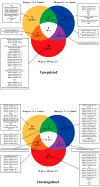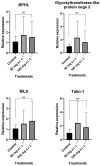Intake of Pyriproxyfen Through Contaminated Food by the Predator Ceraeochrysa claveri Navás, 1911 (Neuroptera: Chrysopidae): Evaluation of Long-Term Effects on Testes via Transcriptome Analysis
- PMID: 40558997
- PMCID: PMC12192672
- DOI: 10.3390/insects16060567
Intake of Pyriproxyfen Through Contaminated Food by the Predator Ceraeochrysa claveri Navás, 1911 (Neuroptera: Chrysopidae): Evaluation of Long-Term Effects on Testes via Transcriptome Analysis
Abstract
Understanding the sublethal effects of insecticides on non-target insects is essential for integrated pest management (IPM). This study aimed to evaluate the differentially expressed genes (DEGs) in the testes of Ceraeochrysa claveri adults exposed to pyriproxyfen during the larval stage. Larvae (0-12 h) were fed Diatraea saccharalis eggs treated with pyriproxyfen (50 and 100 mg a.i. L-1) for 10 days. After this exposure, the larvae were fed untreated eggs until pupation. The testes from the adults were extracted for RNA extraction, library construction, and sequencing. The reads were de novo assembled, and the genes annotated based on their ORF homology. A total of 46 DEGs were identified for the 50 mg a.i. L-1 vs. control, 47 DEGs for the 100 mg a.i. L-1 vs. control, and 64 DEGs for 50 mg vs. 100 mg a.i. L-1 treatments. To validate the DEGs through RT-qPCR, the genes BPHL, Large2, MLX, and Talin-1 were selected. The results indicate that the exposure of C. claveri larvae to pyriproxyfen could alter the gene expression and lead to delayed effects in adults. This study provided a novel approach for assessing the sublethal effects of pyriproxyfen C. claveri and contributed valuable information to enhance IPM strategies.
Keywords: RNA-seq; green lacewing; insecticide; sublethal effects; testis.
Conflict of interest statement
The authors declare no conflicts of interest.
Figures



Similar articles
-
Angiotensin-converting enzyme inhibitors and angiotensin receptor blockers for adults with early (stage 1 to 3) non-diabetic chronic kidney disease.Cochrane Database Syst Rev. 2023 Jul 19;7(7):CD007751. doi: 10.1002/14651858.CD007751.pub3. Cochrane Database Syst Rev. 2023. PMID: 37466151 Free PMC article.
-
Hormone replacement therapy to maintain cognitive function in women with dementia.Cochrane Database Syst Rev. 2002;(3):CD003799. doi: 10.1002/14651858.CD003799. Cochrane Database Syst Rev. 2002. Update in: Cochrane Database Syst Rev. 2009 Jan 21;(1):CD003799. doi: 10.1002/14651858.CD003799.pub2. PMID: 12137718 Updated.
-
Anti-interleukin-13 and anti-interleukin-4 agents versus placebo, anti-interleukin-5 or anti-immunoglobulin-E agents, for people with asthma.Cochrane Database Syst Rev. 2021 Oct 19;10(10):CD012929. doi: 10.1002/14651858.CD012929.pub2. Cochrane Database Syst Rev. 2021. PMID: 34664263 Free PMC article.
-
Immunosuppressive treatment for primary membranous nephropathy in adults with nephrotic syndrome.Cochrane Database Syst Rev. 2021 Nov 15;11(11):CD004293. doi: 10.1002/14651858.CD004293.pub4. Cochrane Database Syst Rev. 2021. PMID: 34778952 Free PMC article.
-
Early erythropoietin for preventing red blood cell transfusion in preterm and/or low birth weight infants.Cochrane Database Syst Rev. 2006 Jul 19;(3):CD004863. doi: 10.1002/14651858.CD004863.pub2. Cochrane Database Syst Rev. 2006. Update in: Cochrane Database Syst Rev. 2012 Sep 12;(9):CD004863. doi: 10.1002/14651858.CD004863.pub3. PMID: 16856062 Updated.
References
-
- Vasilikopoulos A., Misof B., Meusemann K., Lieberz D., Flouri T., Beutel R.G., Niehuis O., Wappler T., Rust J., Peters R.S., et al. An integrative phylogenomic approach to elucidate the evolutionary history and divergence times of Neuropterida (Insecta: Holometabola) BMC Evol. Biol. 2020;20:64. doi: 10.1186/s12862-020-01631-6. - DOI - PMC - PubMed
-
- Neuropterida Species of the World Catalogue of Life Checklist. [(accessed on 25 February 2025)]. Available online: https://www.checklistbank.org/dataset/278910/taxon/3ND.
-
- Freitas S., Penny N.D. The green lacewings (Neuroptera: Chrysopidae) of Brazilian agro-ecossystems. Proc. Calif. Acad. Sci. 2001;52:245–395.
-
- Albuquerque G.S., Tauber C.A., Tauber M.J. Green lacewings (Neuroptera: Chrysopidae): Predatory lifestyle. In: Panizzi A.R., Parra J.R.P., editors. Insect Bioecology and Nutrition for Integrated Pest Management. 1st ed. CRC Press; Boca Raton, FL, USA: 2012. pp. 593–631.
-
- Pappas M.L., Broufas G.D., Koveos D.S. Chrysopid predators and their role in biological control. J. Entomol. 2011;8:301–326. doi: 10.3923/je.2011.301.326. - DOI
Grants and funding
LinkOut - more resources
Full Text Sources

